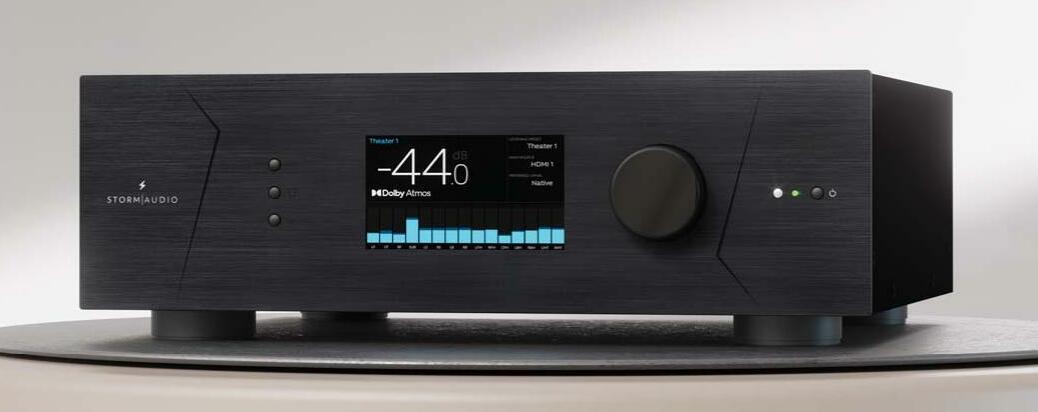
While it does offer a few "legacy" analog inputs, it is for the most part all-digital, input to output, including network connections on both ends. Consequently, it is less likely to leave sonic fingerprints on the music than devices that convert digital to/from analog or modulate their signals with active amplification or attenuation.
It is notable that, despite its audio function, the Storm completely lacks traditional audio specifications-distortion, dynamic range, and so on.
Yes, that aspect of the product was appealing, but the real trigger for me was that when I began this review, the StormAudio ISP Evo was the only consumer device to fully incorporate the latest version of Dirac Live Active Room Treatment (ART). An earlier, more primitive version of ART, called DLBC Full Bass Optimisation, was tantalizing² but ran only on Windows or Mac computers and seemed never to get out of beta status. My expectation for the ISP Evo is that the installation and calibration procedures of this integrated version, which is now fully commercial and public, will be more coherent and smoother and that the results will be even better than before.
That's quite an attractive package, but it comes at the cost of easy integration. The ISP Evo cannot just be plunked down into any audio or home-theater system because its primary output is via network. Since it is "AoIP (AES67/Ravenna) Dante Compatible," it can communicate directly to network-enabled loudspeakers, DACs, amplifiers, and other devices-but not to those that don't speak one of those network dialects. In my setup, I needed to connect it to my PC Server by running the appropriate drivers in order to play files from my library or to stream music from the internet; Merging's MAD ASIO driver package installed on my PC server enabled bidirectional flow of multichannel audio between it and the ISP Evo.
هذه القصة مأخوذة من طبعة March 2024 من Stereophile.
ابدأ النسخة التجريبية المجانية من Magzter GOLD لمدة 7 أيام للوصول إلى آلاف القصص المتميزة المنسقة وأكثر من 9,000 مجلة وصحيفة.
بالفعل مشترك ? تسجيل الدخول
هذه القصة مأخوذة من طبعة March 2024 من Stereophile.
ابدأ النسخة التجريبية المجانية من Magzter GOLD لمدة 7 أيام للوصول إلى آلاف القصص المتميزة المنسقة وأكثر من 9,000 مجلة وصحيفة.
بالفعل مشترك? تسجيل الدخول
INSTANTLY ICONIC
AUDIO SALON HOST/ENTREPRENEUR/SYSTEM AND FASHION DESIGNER DEVON TURNBULL'S RECORD-BREAKING ART OF NOISE SHOWING AT SAN FRANCISCO MOMA.

Buckeye PURIFI EIGENTAKT 1ET9040BA1
Back in 2016,' I documented the rise of class-D amps using the early Tripath technology. Used in the Bel Canto eVo 200.2, TriPath cracked open the door to the High End but was never admitted due to a dim and opaque treble.

Moon 891
No less than eight boxes, powered by six after-market power cables, comprise my current reference front-end.'

Clearaudio Signature
The Clearaudio allowed each mix, each sonic artifact, to reveal its unique character.

Gryphon Audio Designs Diablo 333
What's in a name? Denmark-based Gryphon Audio Designs laid down a marker when company founder Flemming Rasmussen chose that name in 1985. Browsing through the current Stereophile Recommended Components list, I only found one other manufacturer that utilizes an animal moniker.

The Rega Naia Turntable. Add Lightness.
To watch as Rega very slowly expands its turntable offerings upmarket requires the patience of a Thomas Pynchon addict waiting for each new tome from the notoriously slow-working and reclusive author.

Phono Preamplifier Seduction
Give me the seduction, give me the pleasure,\" Ron Sutherland was nearly shouting into the phone. \"I want to turn off the analytical mind and just enjoy myself!\"

Record Player Revelations
Like romance or car racing, the act of playing records is tactile by design. Like drifting through curves or making out, spinning vinyl is a learned skill that requires users to touch everything with practiced assurance.

Taking Care of Business
As Jim Austin wrote in this space in the December 2024 issue, following a medical procedure that he had in mid-October, he needed to take several weeks' leave to recuperate. He delegated the magazine's production to Managing Editor Mark Henninger, AVTech Editorial Director Paul Miller, and myself. The three of us worked with copy editor Linda Felaco and longtime art director Jeremy Moyler to produce the issue you hold in your hands.

Estelon X Diamond Mk II
Taste is a funny thing. Love cilantro? Millions swear it tastes like soap.